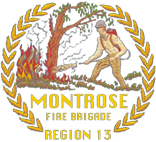The Sixties
The event that dominated the start of the sixties was undoubtedly the devastating bushfire's of 1962. It started at The Basin on Sunday the 15th of January and spread quickly, racing around the mountain towards Montrose and Kalorama. Fanned by a strong wind the heat of the fire became so intense that it raced downhill, a behaviour unusual in fires. In Montrose a heavy pall of smoke obscured the sun for numerous days while cinders and partly burnt leaves fell in the bay side suburbs of Melbourne.
View of mountain from garden of Jean Adams - January 1962
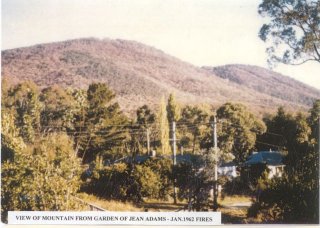
Burnt homes - Browns Rd / Old Coach Rd area
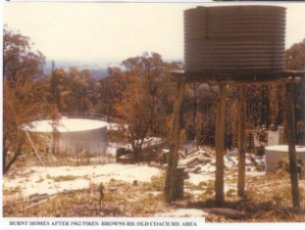
Ted Adams, now Captain, had a problem the magnitude of which had not occurred before. There was precious little equipment, a few trained members and a mass of volunteers – all willing, but neither trained or equipped. It was his task to organise the fire fighting effort. He spent the first 36 hours continuously on duty, training volunteers on the job and organising resources. In Melbourne, the radio stations were calling for more volunteers and men were brought up in buses.
At the time the only fire-fighting vehicle the Brigade operated was an ex-Allied Works truck that they had picked up at Wesburn. Ted Adams spent countless hours working on it, installing a tank and a little pump on the back. The water tank was eventually painted silver, apparently so it could be seen when they were fighting fires during the night. Not surprisingly the truck spent more time at Ted's place getting fixed up than it did at the fire station.
The lack of equipment was made worse by the fact the Brigade was in the process of changing radio frequencies and there was a mix-up in radio communications. As a consequence what little fire fighting equipment the brigade did have was not always put to best use. It was a wake up call for the brigade and the beginning of some more communications improvements.
The Duckett family gateway Old Coach Rd after January 1962 fires

The fires claimed approximately 72 houses. After the fires, a very-well attended public meeting was held to assess what improvements could be made. A committee was then formed and a report was published. 140 new members joined the brigade. Over 1000 pounds was donated and invested for the purchase of future equipment.
Montrose Rural Fire Brigade Area
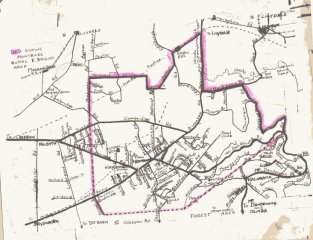
During these testing times community spirit brought together some much-needed assistance. There were no street directories and maps of the area were scarce, so Jean Adams drew up the first Brigade map with assistance from a photographer from The Herald. This map was then placed inside the logbook that was kept in the fire truck. Kevin Beatty, the secretary at the time, undertook a huge mapping project for the region as well as for the Brigades. He made very useful maps that showed water points and access roads, invaluable when fighting fires in unfamiliar territory.
About this time Ted Adams ‘acquired' a siren from a police motorbike, which was put up in the pine tree at the back of his house for the purpose of calling out fire fighters to incidents.
A few dedicated members were also developing other innovative new equipment. Jack Verity contributed a highly effective fire hose washer using an old Coke Cola cooler and a washing machine, while Ted Adams developed the ‘Flame Thrower' used for burning off using a converted knapsack. Fuel reduction burns had become a commonplace activity of the brigade by this time.
Jack Kernahan also participated with his fire safety ideas. One example was the use of a bottle of lemonade as an aid to putting out a stove fire. Another time Jack developed a prototype of a fire suit made of reflective silver material. To test it the Brigade lit a big bonfire while Jack put on his suit and walked as close as he could to it. He nearly suffocated as the glue he had used gave off fumes. But he had the right idea, and today heat resistant suits are a commonplace item of Personal Protective Equipment in many brigades.
CFA issued Bedford Small Town Tanker
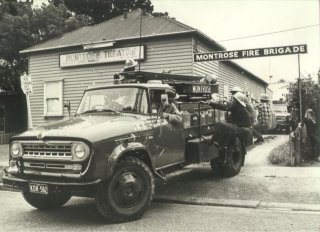
In 1963 the brigade acquired its first Country Fire Authority issued vehicle, a Bedford Small Town Tanker unit to supplement the old Ford the brigade had. To accommodate the new vehicle the station was doubled in size in 1966. In 1969 the brigade realised its investments made earlier in the decade which, along with further donations, permitted the purchase of a 600-gallon tanker.
By the late sixties fire fighting in the state had become a much more organised and regulated activity under the auspices of the Country Fire Authority. Training was organised on a regional basis and the Lilydale Fire Brigade Group ran training courses covering rural, residential and industrial fire fighting. A major contributor to these activities and training committee member was Jack Verity of the Montrose Fire Brigade.
